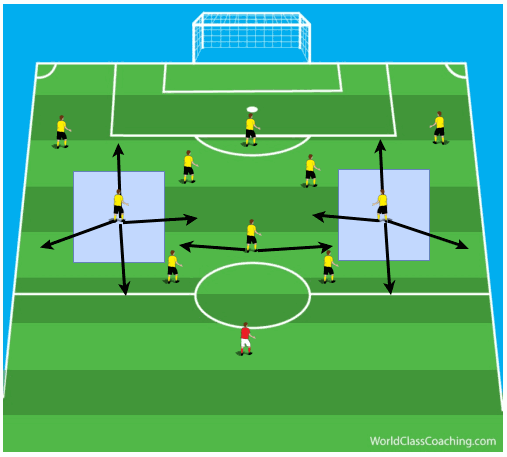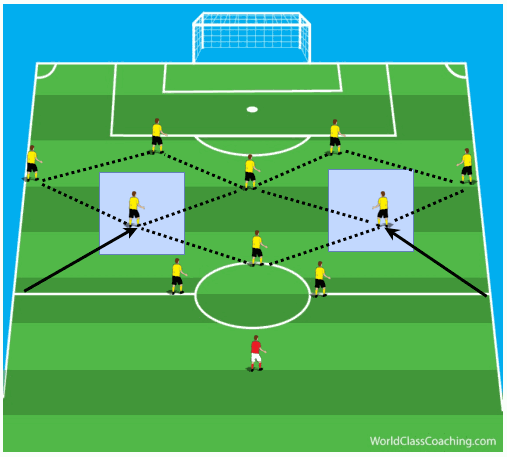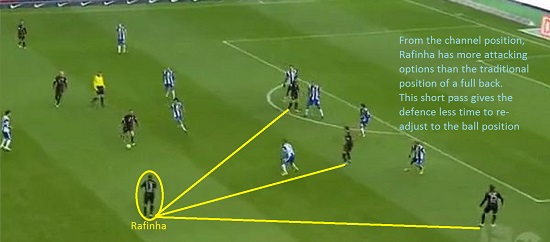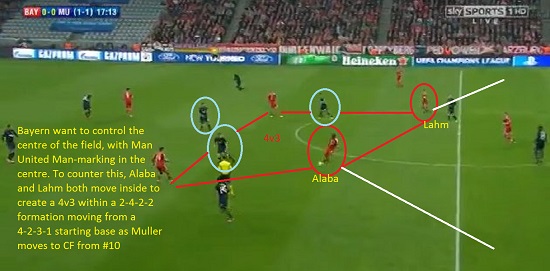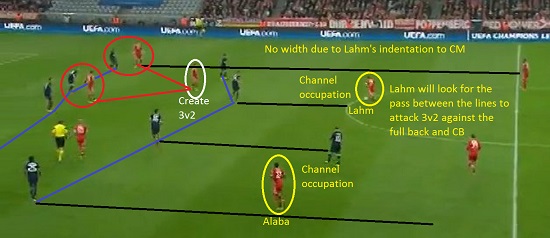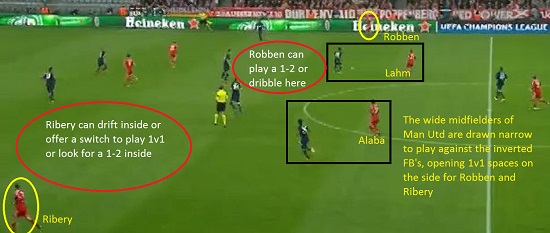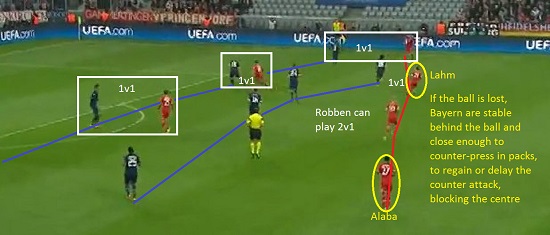By Stevie Grieve
Pep Guardiola has evolved the Bayern Munich team over the 18 months he has been in charge so it is almost unrecognisable from the treble winning team and style Jupp Heynckes left behind. The system has changed so much that the fairly rigid positions of each player has been replaced with a solutions to problems based style, and one major change has been the implementation of ‘inverted full backs’ in the manner that they cover 4 positions from 1 zone, almost like an old fashioned ‘halfback’ from the 1930s.
The positioning of this player allows the team to be flexible in the centre and wide areas, in both attack and defence, and in transition phases where the ‘halfbacks’ can drop off to form a back 4, or press high to counter-press with the 2-1 triangle covering behind them (DM & CBs).
Position of the ‘inverted Full Backs / Halfbacks in a 4-3-3
As we can see, the ‘halfback’ is in the position between centre and wide (the channel) between midfield and defence, providing positional flexibility while other positions appear to be ‘fixed’.
In reality, the Guardiola system provides incredible flexibility and movement between players, working on the premise of looking for overloads and creating diamonds between players. The narrower positioning of the fullbacks/halfbacks provides this.
Angles of attack form the channel position
As Rafinha is in the ‘channel’, he can receive and attack closer to the goal with an outball to a 1v1 with options inside the box. The key here is that in a ‘normal’ FB position, the pass is longer and the defence have more time to adjust while the player has 2 or 3 touches. Here, he can attack 1st time.
Overloading the centre
Against a team playing in a 4-4-2, a 3v2 in central midfield is a common way to gain control in a 4-3-3 or 4-2-3-1. If a team plays a 4-4-1-1, the 3v3 in midfield means that lots of circulation and rotation is needed to gain control, so to find a way around this, a team may use a wide midfielder in a more narrow position to gain control 4v3. This can draw the opposition narrower than the attack would like, so the Guardiola solution os to push both FB’s into the centre, leaving the wide midfielders to play on the same line as the opposition backs 4, either wide or central, offering more penetration choices. This also causes the wide midfielders of the opposition a problem – who do they mark? Do they track wide to the wide attacker and create a situational back 5 or back 6?
Normally as they would be narrow to play compact, they would defend 1v1 with the FB in the wide zone, but the flexible positioning of the full backs makes this a more difficult job than normal.
Looking for penetration opportunities
Lahm and Alaba’s positioning is very deliberate here; they play in the channel which can provide a straight pass into the halfspace to penetrate the midfield on line 2 (between players on the midfield line) or line 3 (between the lines of defence and midfield).
In this example, Lahm wants to find the pass into line 3 where a 3v2 can occur due to the positioning of the attackers on line 4 (against the defence).
Forcing the opponent to lose shape and open up spaces
Isolating the winger who is excellent in 1v1 play by drawing the wide midfielder inside is a difficult task if the full back stays wide as the direct opponent will drop back to help the full back. Instead, by moving inside and drawing the wide midfielder with him, this narrows the midfield and leaves the winger 1v1 against the opposing full back.
[wpsharely id="2988"][/wpsharely]Covering positions ahead of defensive transition
With the movement to indent to play centrally, this reduces the distances between players, covering the width of the field in transition to allow the team to counter-press from a stable position. If the far side full back was wider, there would be a gap between players and leave a space which could be exposed centrally. Instead, with the central positioning, this can block forward passes and force the attack to go around the press, making the route to goal potentially slower and in-direct.
By Stevie Grieve. (Follow on Twitter @steviegrieve) Stevie is also the author Coaching the 4-2-3-1, Coaching the 4-2-3-1 Advanced Tactics and From Futsal to Soccer

